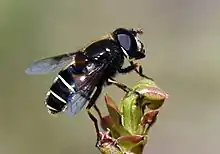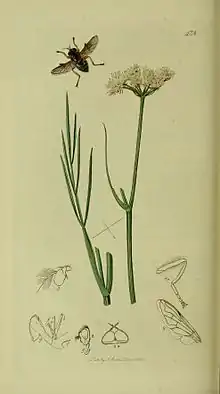Eristalis cryptarum
Eristalis cryptarum is a holarctic species of hoverfly.[1][2][3] Known as the bog hoverfly or bog-dwelling drone fly, it is a bog specialist but may occur in other wetlands.[1] Its larvae are assumed to live in peat that is saturated with water, such as that found in these boggy areas.[4][5] The female has been observed depositing eggs on and close to very fresh cow dung along oligotrophic seepages in moorland.
| Eristalis cryptarum | |
|---|---|
 | |
| Scientific classification | |
| Kingdom: | |
| Phylum: | |
| Class: | |
| Order: | |
| Family: | |
| Subfamily: | |
| Tribe: | |
| Genus: | |
| Subgenus: | Eoseristalis |
| Species: | E. cryptarum |
| Binomial name | |
| Eristalis cryptarum (Fabricius, 1794) | |
| Synonyms | |
E. cryptarum has a wide distribution across central and northern Europe and East to Siberia and Mongolia.[6][7] In England, it was once found in all southwestern counties as far east as the New Forest, but since the middle of the 20th century its range has contracted, for unknown reasons, and it is only now found at a few sites on Dartmoor, Devon. In Denmark it is considered critically endangered, possibly extinct.[5]
Description

For terms see Morphology of Diptera.
- Wing length 6·5–10 mm.
- Last antennomere reddish.
- Scutellum various shades of reddish-orange or yellow.
- Tergites 2-4 whitish pale hind margins.
- Pubescence mainly orange.
- Costal wing edge infuscate.
- Tibia 1-3 entirely orange.[8][9][10][11]
The male genitalia are figured by Hippa et al. (2001) [12] The larva is undescribed.
References
- Skevington, Jeffrey H.; Locke, Michelle M.; Young, Andrew D.; Moran, Kevin; Crins, William J.; Marshall, Stephen A. (2019). Field Guide to the Flower Flies of Northeastern North America. Princeton, New Jersey: Princeton University Press. ISBN 9780691189406.
- Van Veen, M.P. (2004). Hoverflies of Northwest Europe, Identification Keys to the Syrphidae (Hardback). Utrecht: KNNV Publishing. p. 254. ISBN 90-5011-199-8.
- Stubbs, Alan E.; Falk, Steven J. (1983). British Hoverflies: An Illustrated Identification Guide. British Entomological & Natural History Society. p. 253, xvpp.
- Speight, M.C.D. (2011). "Species accounts of European Syrphidae (Diptera)" (PDF). Syrph the Net, the database of European Syrphidae. 65: 285pp.
- "Action plan for Eristalis cryptarum". UK Biodiversity Action Plan. Archived from the original on 2009-07-13. Retrieved 2010-11-27.
- Fauna Europaea
- Peck, L.V. (1988) Syrphidae. In: Soos, A. & Papp, L. (eds.) Catalogue of Palaearctic Diptera, 8: 11-230. Akad.Kiado, Budapest.
- Van Veen, M. (2004) Hoverflies of Northwest Europe: identification keys to the Syrphidae. 256pp. KNNV Publishing, Utrecht.addendum
- Van der Goot,V.S. (1981) De zweefvliegen van Noordwest - Europa en Europees Rusland, in het bijzonder van de Benelux. KNNV, Uitgave no.32: 275pp. Amsterdam.
- Bei-Bienko, G.Y. & Steyskal, G.C. (1988) Keys to the Insects of the European Part of the USSR, Volume V: Diptera and Siphonaptera, Part I. Amerind Publishing Co., New Delhi. ISBN 81-205-0080-6.
- Coe, R.L. (1953) Diptera: Syrphidae. Handbks.ident.Br.insects, 10(1): 1-98. R.ent.Soc.London. pdf
- Hippa, H., Nielsen, T.R. & van Steenis, J. (2001) The west Palaearctic species of the genus EristalisLatreille (Diptera, Surphidae). Norw.J.Entomol., 48: 289-327.